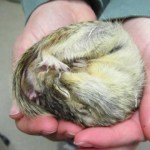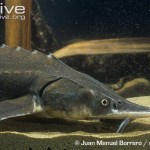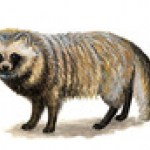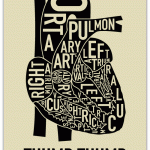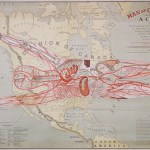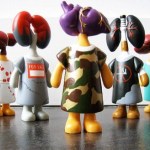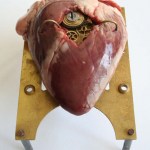Heart
...in alligators at least.
Image of alligator eggs and hatchling from National Park Service.
Researchers from the University of Manchester, University of North Texas - Denton, and the Rockefeller Wildlife Refuge - Grand Chenier, Louisiana teamed up to explore the effects of exposure to low oxygen on embryonic American alligators (Alligator mississippiensis). Alligator eggs are often laid in nests where oxygen concentrations can reportedly vary between 11-20% (21% is normal atmospheric levels). This is really important as issues related to…
Image of a hibernating thirteen-lined ground squirrel from University of Minnesota Duluth researcher Matthew Andrews.
Thirteen-lined ground squirrels (Ictidomys tridecemlineatus) are really cute when they hibernate (above). During torpor bouts, their body temperature decreases to a few degrees Celsius and their metabolism drops by as much as 95% with heart rates ranging from only 3-10 beats per minute. These bouts of torpor are interrupted by periodic arousals every couple of weeks during which their metabolism increases as body temperature elevates to 37 degrees…
"Drosophila melanogaster - side (aka)" by André Karwath aka Aka - Own work. Licensed under CC BY-SA 2.5 via Wikimedia Commons -
Researchers at the University of California at San Diego were interested in understanding how exposure to low oxygen concentrations impact heart function. For humans low oxygen delivery to the heart can occur with exposure to high altitude, respiratory diseases, inflammation, blood clots and during a heart attack when there is inadequate blood flow to the heart muscle. The results of their study were recently published in the American Journal…
Image from The Telegraph (www.telegraph.co.uk Photo credit: Alamy)
Granted this is not comparative physiology, I thought this study was really interesting.
Research has shown that exposure of developing embryos to caffeine in utero can alter the expression of genes in the heart leading to changes in how the heart develops and functions in adult animals. New research from the University of Florida published in the American Journal of Physiology - Regulatory, Integrative and Comparative Physiology has examined changes in specific genes they believe are altered by physiologically-…
Siberian sturgeon in captivity
Drs. Thomas Eliot Haworth and Holly Shiels (University of Manchester) teamed up with Drs. Jaakko Haverinen and Matti Vornanen (University of Eastern Finland) to explore how electrical signaling in the hearts of fish have evolved by comparing Teleost fish with sturgeons. Their findings were published this month in the American Journal of Physiology - Regulatory, Integrative and Comparative Physiology.
According to the study authors, there are currently approximately 27,000 species of ray-finned fishes which make up 99% of all fishes existing today. Teleost…
Image from the American Physiological Society's website.http://www.the-aps.org/mm/Conferences/APS-Conferences/2014-Conferences/…
Tuesday was no less exciting than Monday!
Here are some highlights:
I thoroughly enjoyed a session called "Overcoming a Major Physiological Barrier: Adaptation from Saline to Freshwater Habitats" which highlighted the need for several species to shift how they regulate ion balance when they migrate between fresh water (ion absorption from the water) and salt water (ion secretion to the water).
Clements K, Bojarski L, Johnson K, McMillan S, White L, Angert E (Univ…
Image of a naked mole rat from www.animals.sandiegozoo.org
The naked mole rat is the longest lived rodent species (>31 years). Unlike most mammals, they seem resistant to many age-associated ailments until much later in life, making them an exciting model of healthy aging. They are also resistant to the development of cancer as mentioned in this prior post.
According to the CDC, cardiovascular disease is currently the leading cause of death in the United States, claiming the lives of roughly 600,000 people annually (or 1 out of every 4 deaths). In a new study published in the American…
Day 3 of the Experimental Biology meeting was arguably one of the most exciting for comparative physiology. Here are the highlights from Monday:
Morning Seminars:
Birgitte McDonald from Aarhus University, Denmark presented, "Deep-diving sea lions exhibit extreme bradycardia in long-duration dives." Birgitte and Dr. Paul Ponganis measured the heart rate of California sea lions (Z. californianus) using digital electrocardiogram loggers and found that the heart rate was reduced (bradycardia) during dives along with reduced blood flow to the lungs and periphery. This helps preserve the oxygen…
A bad day for your ego is a great day for your soul. -Jillian Michaels
One of the most popular exercises at the gym is the treadmill. And why wouldn't it be? Whether you're running or walking, it's a great way to get your heart rate up, get your body moving, and for many people, a great way to burn calories.
But however you use a treadmill, there's one extremely simple thing you can do to dramatically intensify your workout: incline it!
If you're an outdoor walker/runner, this is the equivalent of going uphill instead of over level ground. There are many physiological differences in walking…
Father Heart, 2006
Black Nickel on Rolled Steel; Glass Tank - 80cc with pedal
Josh Hadar
It's always puzzled me that bicycles don't take better advantage of the gleaming potential of curvacious, polished metal. Why are most bike frames so boring and triangular? Fortunately Josh Hadar has come to the rescue, with his beautiful curved steel custom bicycles. They're all lovely, but when he adds blown glass "hearts" to their steel ribs, his bikes seem positively. . . alien. Isn't it interesting that adding elements of human anatomy makes the bikes seem more unnatural? More bikes (and the…
As a fan of maps, typography, and anatomy, I think this is a pretty sweet mashup.
From orkposters.com via Street Anatomy.
Another fabulously weird map, from the great blog Strange Maps. This one is entitled "The Man of Commerce" and dates to 1889.
According to the American Geographical Society Library,
The highly detailed 31" x 50" map/chart conflates human anatomy with the American transportation system, in an apparent attempt to promote Superior as a transportation hub.Its metaphor makes West Superior "the center of cardiac or heart circulation"; the railways become major arteries; and New York is "the umbilicus through which this man of commerce was developed."The explanatory notes conclude: "It is an…
Okay, these dolls by David Foox are just plain disturbing. And they're not just a concept - you can actually BUY ONE.
Via Street Anatomy.
The Lady of Broken Hearts
Natalie Shau
Lithuanian artist Natalie Shau works in digital media, mostly using Photoshop. You can see more of Shau's work at her website and at the website of jewelery designer Lydia Courteille, for whom she illustrated a cabinet-of-curiosities themed ad campaign. hat-tip: Haute Macabre.
It is literally very difficult to mend a broken heart. Despite its importance, the heart is notoriously bad at regenerating itself after injury. If it is damaged - say, by a heart attack - it replaces the lost muscle with scar tissue rather than fresh cells. That weakens it and increases the chance of heart failure later on in life. No wonder that heart disease is the western world's leading cause of death and illness.
If that picture seems bleak, two teams of scientists have some heartening news for you. The first has found that the heart does actually have the ability to renew its cells,…
Fixed Heart
offal with mixed metal components
Lisa Black, 2008
I blogged about New Zealand artist Lisa Black before, but I can't get over this great piece of hers. What does it signify? Does it represent the gradual replacement of the natural world around us with technology, to the point where our own bodies become artificial? Is it critiquing the reductionist tendencies of neurobiologists who believe our deepest emotions are complex but purely chemical reactions? Is it a steampunk Valentine? I don't know, and I don't really care - it's just cool.
Check out more from Black here.
This revealing anatomical card by Oregon designer Nathan Chrislip can be had for only $9 plus shipping on etsy. (Chrislip calls it a "valentine," but unless your beloved is also an avowed anatomophile, be sure to enclose a message making your nonviolent romantic intent clear.)
Via Rag and Bone Blog
